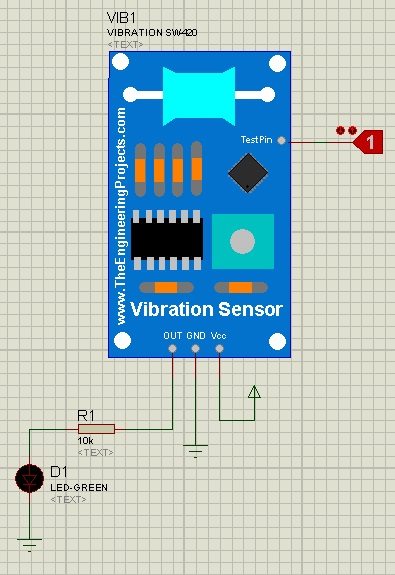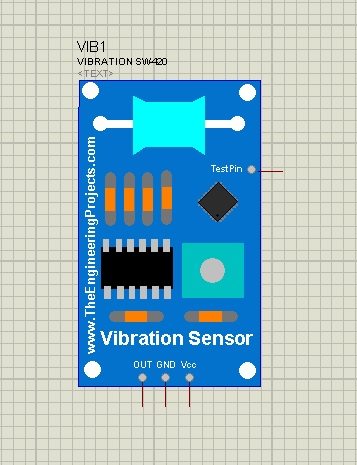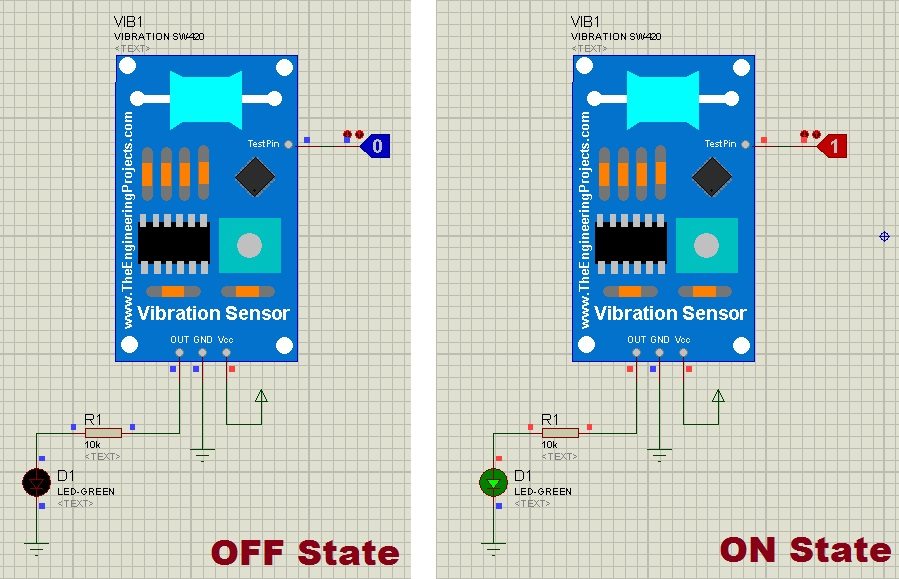
Hello friends, I hope you all are fine and having fun with your lives. Today, I am going to share a new Proteus Library named Vibration Sensor Library for Proteus. This Library is designed by our team on TEP and it's not yet published anywhere. We are the first creator of this Vibration Sensor Library for Proteus. This Library contains just one Vibration Sensor named SW-420. I will post a tutorial soon on interfacing this SW-420 Vibration Sensor with Arduino. This library is compatible with all the microcontrollers like Arduino, PIC Microcontroller or 8051 Microcontroller etc. You should also have a look at Analog Vibration Sensor Library for Proteus.
Using this Library you can now easily Simulate your Vibration Sensor in Proteus ISIS software. As we can't produce real vibration in the Proteus environment so that's why I have placed a TestPin in this Vibration sensor. If you send 0 at this TestPin then it means no vibration and if you sent 1 then it means we have some vibration. The Library is given below for download along with a simple simulation of this vibration sensor. So, let's get started with Vibration Sensor Library for Proteus:
Note: Other Proteus Libraries are as follows:- Arduino Library for Proteus.
- Genuino Library for Proteus.
- GPS Library for Proteus.
- XBee Library for Proteus.
- Ultrasonic Sensor Library for Proteus.
- PIR Library for Proteus.
- Bluetooth Library for Proteus.
Vibration Sensor Library for Proteus
- First of all, download the Library Files for Vibration Sensor Library for Proteus by clicking the below button:
- When you download the file then it will contain three files named as:
- VibrationSensorTEP.IDX
- VibrationSensorTEP.LIB
- VibrationSensorTEP.HEX
- Place all these three files in the Library folder of Proteus software.
- If you are new to Proteus 7 Professional, then you should have a look at How to add new Library for Proteus 8 Professional.
- Now restart your Proteus software if it's already open.
- In the components search box, you have to search for Vibration Sensor, and you will get Vibration Sensor SW-420.
- Now place it on your Proteus workspace and it will look something as shown in the below figure:

- You can see in the above figure that our sensor has four pins, which are:
- The first one is Vcc so apply +5V here.
- The second Pin is GND so apply ground here.
- The third Pin is OUT, it's the output pin from where you get whether there's vibration or not.
- The fourth Pin is TestPin and if it's HIGH then it means you have vibration and the OUT PIn will go HIGH and if it's LOW then it means there's no vibration and OUT Pin will also be LOW.
- Now the last thing you need to do is to double click this sensor to open its Properties.
- In the properties, you will find a Program File, in this section browse to your file VibrationSensorTEP.HEX which we just downloaded and placed in the Library folder of Proteus software.
- Once uploaded now you can use your Vibration Sensor in Proteus, the hex file is adding the functionality in this Vibration Sensor.
- Now let's design a simple example to get an idea of how this sensor works.
- So, in order to do that, design a simple circuit as shown in the below figure:

- Now run your simulation, when you make TestPIN LOW, the sensor won't give any output and when you make TestPIn HIGH, the sensor will give an output, which means vibration is detected as shown in the below figure:

- The above image is quite self-explanatory. :P
- The below video will give you a better idea of how it works:
That's all for today. I hope you will enjoy this Vibration Sensor Library for Proteus. I have just added one module right now but I am gonna add more soon. You should also have a look at these New Proteus Libraries for Embedded Systems Projects. Take care !!! :)



